I’m lucky – I live in an area that doesn’t get too cold in winter. This makes late fall, winter, and early spring the busiest time of year – a time filled with cutback, needle-plucking, wiring, and repotting.
I was thinking, this afternoon, of what I can do to make my pines as vigorous as possible next year. The first item that came to mind was fertilizing early. While repotting season runs through February and occasionally into March, there is generally a 24-30 day gap between repotting and fertilizing to give new roots a chance to grow before they’re presented with food. If I repot in February, I can fertilize in March.
To get a jump on this, I need to repot on the early side. Which means I need to cut, pluck and wire my pines as soon as I can get to them before I repot. And before I can repot I need to get all of my supplies in order. This is why I’m spending a beautiful fall day washing, sifting, and mixing bonsai soil.

Ready Mix
I’ll skip past the potential ingredients of good bonsai soil and skip to the important part: they must be clean and dry. The photo below shows the pumice I use as purchased.

Unwashed pumice
Great soil medium, but very dirty in this case. Pumice is very light – important when repotting large bonsai – and it retains enough moisture to make it a good ingredient for most mixes. You can use more in wet areas or for trees that require less water. You can use less in arid areas or for trees that like water. The goal, in either case, is to get it looking like this before using it:
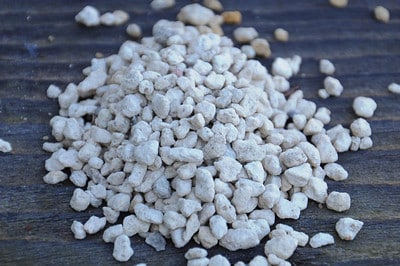
Clean pumice
Which, again, is why I’m washing bonsai soil today. I usually clean and dry my bonsai soil over the summer so all’s set by now, but this summer was busy and now is my last chance before repotting begins.
All of the ingredients I use in bonsai soil, save pumice, come clean enough for me to simply dry and sift before using. Drying alone doesn’t always cut it for pumice. For most of my 15 years in bonsai I’ve been washing it with a setup something like this:
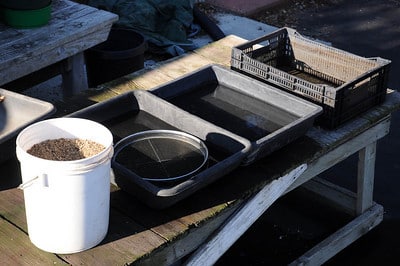
Bonsai soil washing station
I fill up 5 gallon buckets of dirty soil and pour some into a soil sifter set in a tub of water. I rinse the soil in two of such tubs to wash the fine particles away and pour the remainder into a container that drains well so the soil can dry.
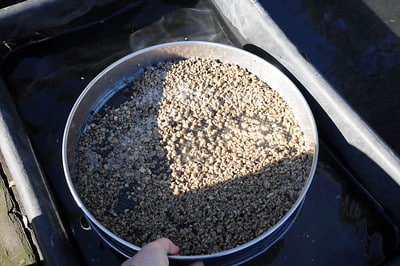
Wash
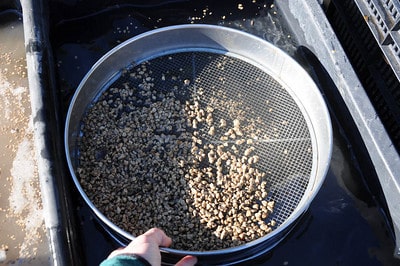
Rinse
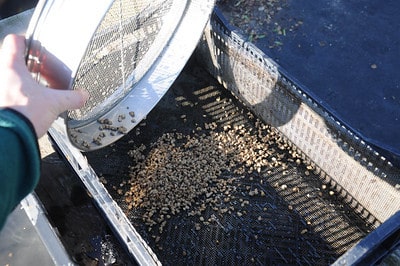
Repeat
Removing these fine particles is necessary to promote healthy growth. Fine particles impede drainage which limits the amount of air, water, and fertilizer one can supply to bonsai. Limiting these limits overall growth and vigor for young trees and old. Good health starts with the roots and without good health there is no good work. This is why good bonsai begins with repotting.
Subscribe to Bonsai Tonight
New Posts Delivered Every Tuesday and Friday
Scott Straley says
Jonas,
Great article on something that is so important in bonsai-great soil. I must admit to using the pre-mix this last year (3 1/2 bags), but due to this crazy economy, will be back to making my own mix this year. I also like to set a day aside to prepare the soil, and with our repotting schedule coming up soon, the sooner the better.
Your soil washing station is a great set up, nice work.
Scott
George Haas says
I enjoyed this article on pumice and getting ready for winter chores. How about a follow-on article about bonsai soil mix(es)? Thanks
xwires says
Thanks George – will do. I’m planning to say more about the topic when I start repotting this season.
Zack Clayton says
How does Akadama and some of the fired clay products like Turface or MVP or even haydite (fired shale) differ? Its my understanding that Akadama is a naturally fired clay from a clay bed being buried under lava – maybe folk lore, but that is what I remember. If it is really low pressure low temperature metamporphic clay – wouldn’t the commercial prepared material be equivalent?
xwires says
I haven’t had a lot of experience with Turface, MVP or haydite, but I know other readers here have. I’ll be curious to hear further details if anyone has them.
Janet says
Several years ago – and I wish I could remember when – Golden Statements ran an article form someone who explaining what Akadama actually was (the chemistry and the geologic source). The only specific I remember is that it is definitely not clay (fired or otherwise), and my memory is that it is a volcanic product.
It was a great article, and maybe someday I’ll dig it up. Unfortunately their online archive only goes back through 2008.
Michael says
I hope this will answer the question on akadama 😉
Technically, both akadama and kanuma are pumices… porous leftovers from a pyroclastic flow in a low pressure environment, with a density lower than 1 thanks to all the gases that were trapped when the flow cooled down. Those pumice layers started decomposing thanks to the water percolating through… carrying minerals from layer to layer (volcanic ash, imaichi, volcanic ash with a mix og imaichi and kanuma, clay mixed with volcanic ash).
What we call akadama is Imaichi pumice. There is another layer of pumice on top in one area of Tochigi called the Shichihonzakura pumice layer… but I don’t know the commercial name used for that product.
Source: Clay and Clay Minerals of Japan, Volume 25, Part 1 By Toshio Sudō, Susumu Shimoda pp 115-125